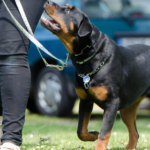Rottweilers are best known for their intelligence, strength, loyalty, and protection instincts. They are misunderstood by the public sometimes, but beneath their strong muscular build is the soft heart of the most affectionate and loyal dog you will ever have. These dogs are highly intelligent and respond well to training, making them easy to handle and control. When properly trained, rottweilers have the ability to effectively safeguard their families against any potential danger or harm.
What do people have to say about a trained rottweiler?
- Trained Rottweilers are Safer
One of the main benefits of training a rottweiler is that it can help to prevent dangerous or destructive behavior. Trained Rottweilers are more likely to follow commands and be under control in a variety of situations, which can help to keep them and others safe. For example, training can help to prevent a rottweiler from becoming aggressive or biting and can teach them to stay calm and relaxed in new or stressful environments. Trained Rottweilers are less likely to bark excessively or pull on their leash, which can make them more enjoyable to be around for both their owners and others.
- Trained Rottweilers are Better Companions
Another benefit of training a rottweiler is that it can help to strengthen the bond between the dog and its owner. Training provides an opportunity for owners to communicate with their rottweilers and to help them understand what is expected of them. When training is positive and reinforcing, it can help rottweilers to feel more secure and confident, which can make them better companions. In addition to improving the relationship between owners and their rottweilers, training can also help to reduce behavioral issues that can be disruptive or unpleasant.
- Trained Rottweilers are More Confident
Finally, many people believe that training can help rottweilers to be more confident and self-assured. Training provides an opportunity for rottweilers to learn new skills and to interact with their environment in a positive way. This can help to build their confidence and to reduce the likelihood of anxiety or fear-based behavior. In addition, training can help rottweilers to be more comfortable in new or challenging environments. For example, training can help them to be calm and relaxed in public places, or to interact with other dogs or people in a positive way. This can help to increase their overall confidence and to make them better adjusted to different situations.
But how would you train a rottweiler?
What are rottweiler training secrets?
- Be Patient and Consistent
Rottweilers respond best to positive reinforcement and consistent training. Patience and consistency are essential for building a strong bond with your pet as well as establishing desired behaviors. To ensure consistency in training, it’s important to establish a regular training schedule. This could include daily obedience training sessions, as well as exposure to new environments and socialization opportunities.
- Impose positive reinforcement
Positive reinforcement is one of the most effective methods for training Rottweilers. This technique involves rewarding desired behaviors with treats, praise, or affection, which reinforces and encourages the dog to repeat the behavior.
- Avoid Harsh Methods
Harsh methods, such as punishment or aggression, can damage the bond between owner and pet and lead to fear and aggression in the dog. Positive reinforcement and consistency are much more effective in achieving desired behaviors and building a strong relationship with your Rottweiler.
- Give short commands
Ideal basic obedience training starts young, between 6 weeks and 6 months. Teach only one new trick at a time, and keep training sessions short and enjoyable. Remember to stay calm and assertive. Some of the essential obedience commands include “Sit”, “Stay”, “Down”, “Come”, and “Shake”. Owners should start with basic obedience commands and gradually increase the difficulty level, allowing the dog to successfully complete each task before moving on to the next.
- Take Breaks and Stay Patient
Rottweilers, like all dogs, have a limited attention span, and taking breaks during training sessions can help to avoid frustration and burnout. Owners should also be patient, allowing the dog to learn at its own pace and providing positive reinforcement for progress and improvement.
What have we learned?
Rottweilers are strong, yet gentle dogs. A trained rottweiler has a variety of benefits, including increased safety, better companionship, and increased confidence. Effective rottweiler training requires patience, consistency, and positive reinforcement. The use of positive reinforcement, such as rewarding desired behaviors with treats or praise, is much more effective than harsh methods, such as punishment or aggression. By following these secrets, owners can train their rottweilers to be well-behaved, obedient, and valued members of their families.







